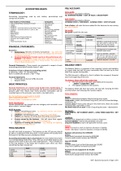Summary
Summary LPC Notes Business Accounts Revision Notes (Distinction) 2021
- Module
- Business Law and Practice
Why to waste money on notes that simply replicate the materials you receive in class? These Revision notes have been restructured and optimised for exams. I have spent months simplifying the material to make sure that they are easy to understand using a structured step-by-step guide and clear tab...
[Show more]



